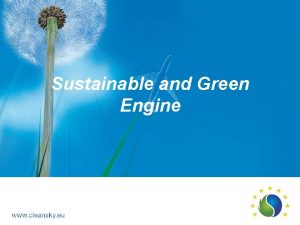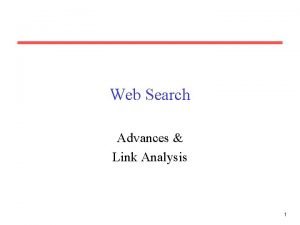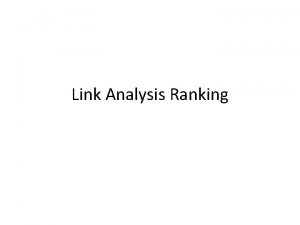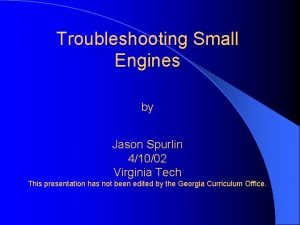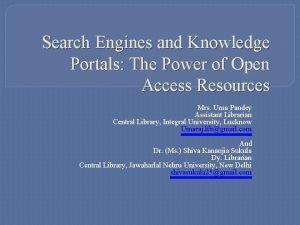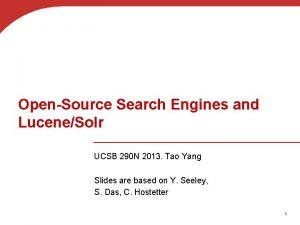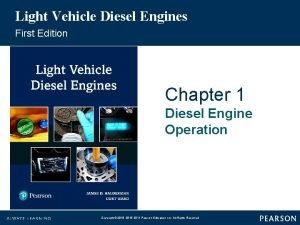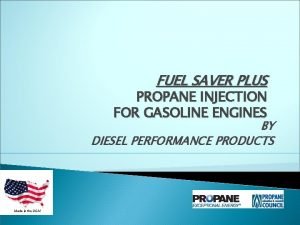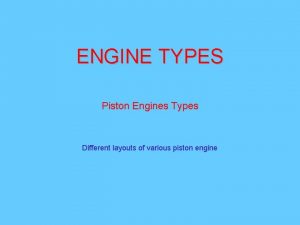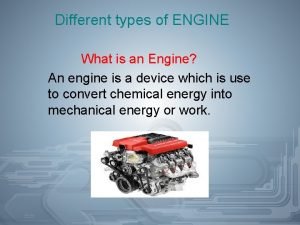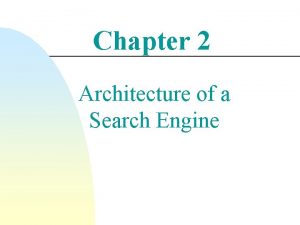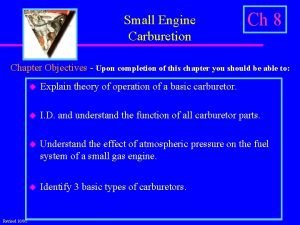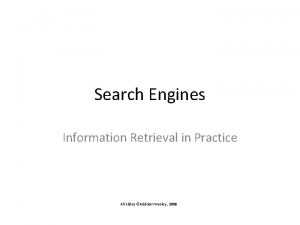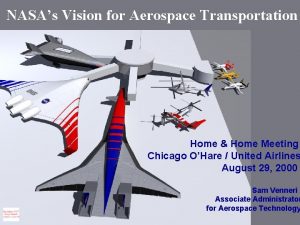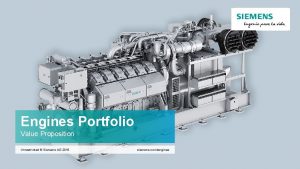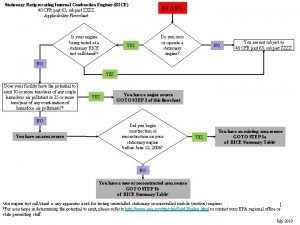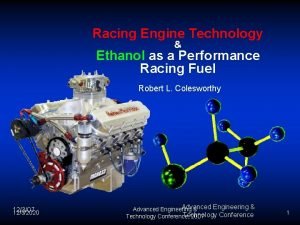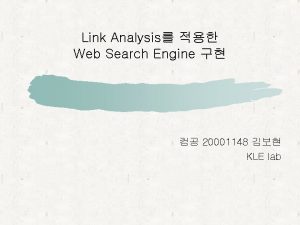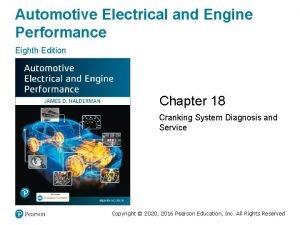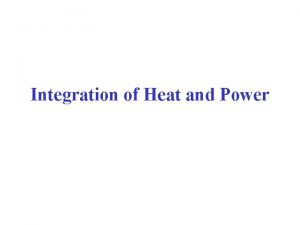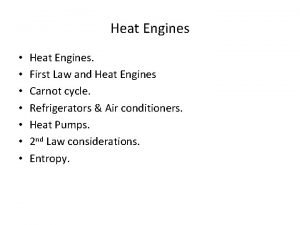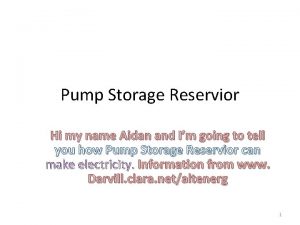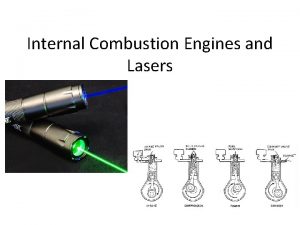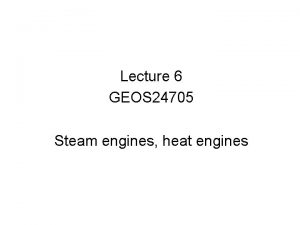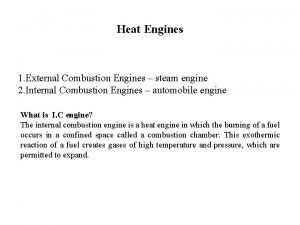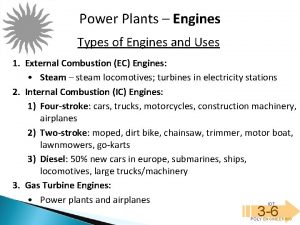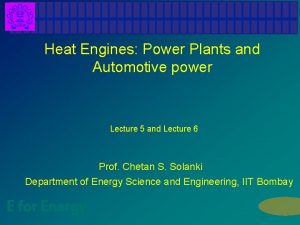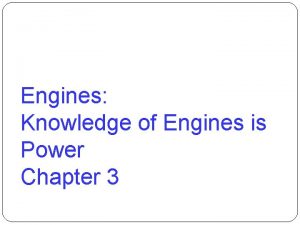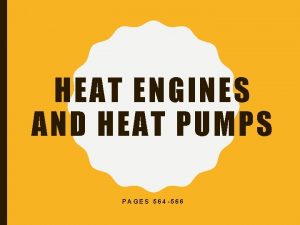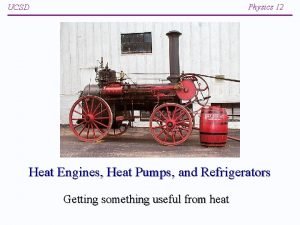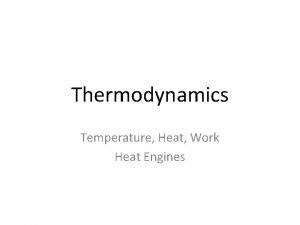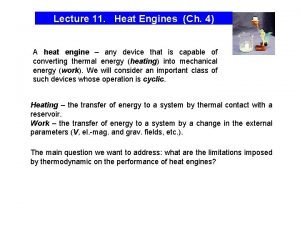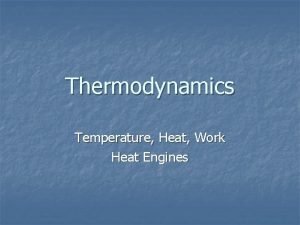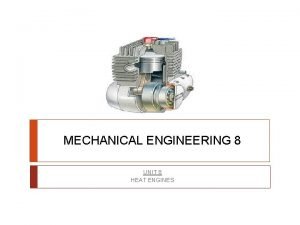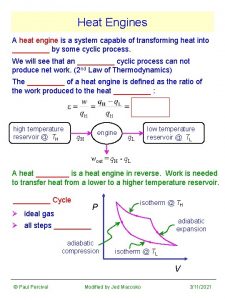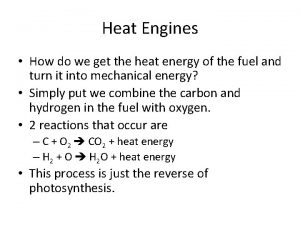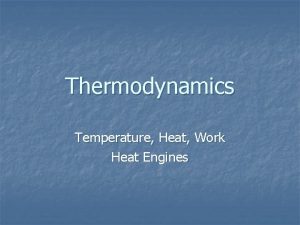Integration of Heat and Power HEAT ENGINES RESERVIOR
































- Slides: 32

Integration of Heat and Power

HEAT ENGINES RESERVIOR T 1 Q 1 Heat Engine W Q 2 RESERVIOR First Law of Thermodynamics W = Q 1 - Q 2 Second Law of Thermodynamics W 7 c Q 1 where T -T 7 c = 1 2 T 1 T 2

HEAT PUMPS RESERVIOR T 1 Q 1 Heat Pump W Q 2 RESERVIOR First Law of Thermodynamics Q 1 = W + Q 2 Second Law of Thermodynamics W 7 c Q 1 where T -T 7 c = 1 2 T 1 T 2

F 1(=QHmin) T heat source F 2 Q F 3 F 4 W F 5 Q-W heat sink (F 6) PINCH 0 F 7 F 8 F 9 H = F 1 + Q C = Fn+1 + Q - W F 10 Fn+1(=QCmin)

T HEAT ENGINE O W cold utility (Q-W)=F 1 F 2 hot utility F 3 F 4 F 5 (F 6) PINCH 0 F 7 F 8 F 9 H =Q C = Fn+1 F 10 Fn+1

T F 1 + O F 2 F 3 F 4 F 5 (F 6) PINCH HEAT ENGINE 0 F 7 F 8+(Q-W) F 9+(Q-W) F 10+(Q-W) H =F+Q C = Fn+1 + Q - W Fn+1+(Q-W) W

F 1 T F 2 F 3 F 4 F 5 (F 6) PINCH 0 F 7 F 8 F 9 HEAT ENGINE (d) F 10 O = Fn+1 W (Q-W) H = F 1 C =Q-W

Q Q W W (Q-W) = F 1 T F 2 F 3 F 4 F 5 (F 6) PINCH 0 F 7 F 8 F 9 F 10 Fn+1 (a) (Q-W) H : Q + Q C : Fn+1 + (Q - W)

Q ZERO FLOW T W X 1 F 2 = 0 X 2 F 3 = 0 X 3 F 4 = 0 X 4 F 5 = 0 (F 6) PINCH X 5 0 (= F 1 in (a)) F 7 F 8 F 9 F 10 Fn+1 (b) H : Q C : Fn+1

F 1 - W T F 2 W Q+W F 3 Q F 4 Q W Q F 5 PINCH HEAT PUMP (F 6) 0 F 7 F 8 F 9 F 10 Fn+1 (b) IN : F 1 - W + W OUT : Fn+1

F 1 T F 2 F 3 F 4 F 5 PINCH (F 6) 0 F 7 F 8+Q+W F 9+Q+W F 10 + W Q+W Q Fn+1 + W (b) W HEAT PUMP IN : F 1 + W OUT : Fn+1 + W

T PINCH F 1 (Q+W) F 2 (Q+W) F 3 (Q+W) F 4 (Q+W) F 5 -(Q+W) Q+W (F 6) 0 F 7 Q W Q HEAT PUMP F 8 Q IN : F 1 - (Q+W) = F - Q OUT : Fn+1 - Q F 9 Q F 10 Q Fn+1 + W (c)

Complex Distillation Configurations

(a) A A B C B B C C Figure 5. 1 The direct and indirect sequences of simple distillation columns for a threecomponent separation. (From Smith and Linnhoff, Trans. IChem. E, Ch. ERD, 66: 195, 1988; reproduced by permission of the Institution of Chemical Engineers. )

(b) A B C A B A A B C B Figure 5. 1(續) The direct and indirect sequences of simple distillation columns for a three -component separation. (From Smith and Linnhoff, Trans. IChem. E, Ch. ERD, 66: 195, 1988; reproduced by permission of the Institution of Chemical Engineers. )

A B C A B (Vapor Sidestream) C (a) More than 50% middle component and less than 5% heaviest component. Figure 5. 10 Distillation columns with three products. (From Smith and Linnhoff, Trans. IChem. E, Ch. ERD, 66: 195, 1988; reproduced by permission of the Institution of Chemical Engineers. )

A B C A B (Liquid Sidestream) C (b) More than 50% middle component and less than 5% lightest component. Figure 5. 10(續) Distillation columns with three products. (From Smith and Linnhoff, Trans. IChem. E, Ch. ERD, 66: 195, 1988; reproduced by permission of the Institution of Chemical Engineers. )

A B Partial Condenser A B C A B B B C Partial Reboiler C (a) Sequence for three product separation using nonadjacent keys (b) Figure 5. 11 Choosing nonadjacent keys leads to the prefractionator arrangement.

A B Partial Condenser A B C A B B C Partial Reboiler C (a) (b) Prefractionator arrangement Figure 5. 11(續) Choosing nonadjacent keys leads to the prefractionator arrangement.

A B C A COLUMN 1 B C A COLUMN 2 B C B B C C Figure 5. 12 Composition profiles for the middle product in the columns of the direct sequence show remixing effects. (From Triantafyllou and Smith, Trans. IChem. E, part A, 70: 118, 1992; reproduced by permission of the Institution of Chemical Engineers. )

COLUMN TOP COLUMN 1 COLUMN 2 RE-MIXING IN COLUMN 1 COLUMN BOTTOM 0 Mole Fraction of B 1. 0 Figure 5. 12(續) Composition profiles for the middle product in the columns of the direct sequence show remixing effects. (From Triantafyllou and Smith, Trans. IChem. E, part A, 70: 118, 1992; reproduced by permission of the Institution of Chemical Engineers. )

Partial Condenser A B C A B Partial Reboiler C Figure 5. 13 Composition profiles for the middle product in the prefractionator arrangement show that there are no remixing effects. (From Triantafyllou and Smith, Trans. IChem. E, part A, 70: 118, 1992; reproduced by permission of the Institution of Chemical Engineers. )

COLUMN TOP MAIN COLUMN Prefractionator Top Prefractionator Feed PREFRACTIONATOR Sidestream Stage Prefractionator Bottom COLUMN BOTTOM 0 Mole Fraction of B 1. 0 Figure 5. 13(續) Composition profiles for the middle product in the prefractionator arrangement show that there are no remixing effects. (From Triantafyllou and Smith, Trans. IChem. E, part A, 70: 118, 1992; reproduced by permission of the Institution of Chemical Engineers. )

A A B C B 1 3 2 4 C (a) Thermally-coupled direct sequence (b) Figure 5. 14 Thermal coupling of the direct sequence.

A B C 1 A B 3 2 4 C (a) (b) Side-rectifier arrangement Figure 5. 14(續) Thermal coupling of the direct sequence.

A A B C 1 3 2 4 C (a) Thermally-coupled indirect sequence B (b) Figure 5. 15 Thermal coupling of the indirect sequence.

3 A B C A 2 4 1 C (a) B (b) Side-Stripper arrangement Figure 5. 14(續) Thermal coupling of the indirect sequence.

Partial Condenser A A B C B Partial Reboiler C (a) Prefractionator arrangement (b) Figure 5. 17 The thermally coupled prefractionator can be arranged in a single shell.

A Main Column A B C (a) (b) Thermally coupled prefractionator(Petlyuk Column) Figure 5. 17(續) The thermally coupled prefractionator can be arranged in a single shell.

A Main Column A B C (b) B (C) Dividing wall column C Figure 5. 17(續) The thermally coupled prefractionator can be arranged in a single shell.

T A B C A B C 1 C 2 C Figure 5. 18 Relationship between heat load and level in simple and prefractionator sequences. (From Smith and Linnhoff, Trans. IChem. E, Ch. ERD, 66: 195, 1988; reproduced by permission of the Institution of Chemical Engineers. ) H

A A B C T B C 2 C Figure 5. 18(續) Relationship between heat load and level in simple and prefractionator sequences. (From Smith and Linnhoff, Trans. IChem. E, Ch. ERD, 66: 195, 1988; reproduced by permission of the Institution of Chemical Engineers. ) H
 Power triangle diagram
Power triangle diagram Forward integration and backward integration
Forward integration and backward integration Vertical integration
Vertical integration Simultaneous integration and sequential integration
Simultaneous integration and sequential integration Chapter 5 two-cycle and four-cycle engines answers
Chapter 5 two-cycle and four-cycle engines answers Sage game engine
Sage game engine Library book drawing
Library book drawing Engines link analysis and
Engines link analysis and Engines link analysis and
Engines link analysis and Troubleshooting small engines
Troubleshooting small engines Siege engines
Siege engines Knowledge search engines
Knowledge search engines Meta search engines compared
Meta search engines compared Open source search engines
Open source search engines Light vehicle diesel engines
Light vehicle diesel engines Propane injection for gas engines
Propane injection for gas engines Different engine layouts
Different engine layouts Whats engine displacement
Whats engine displacement Harper industries has $900 million
Harper industries has $900 million Search engine architecture
Search engine architecture Other search engines
Other search engines Principle of carburetion
Principle of carburetion Information retrieval slides
Information retrieval slides Dot search
Dot search Aircraft engines
Aircraft engines Hz121800
Hz121800 Avaya identity engines
Avaya identity engines Reciprocating internal combustion engines rice
Reciprocating internal combustion engines rice Slatten racing engines
Slatten racing engines Search engines information retrieval in practice
Search engines information retrieval in practice Without rush without engines poetic device
Without rush without engines poetic device Automotive engines 8th edition
Automotive engines 8th edition Www.sbu
Www.sbu





